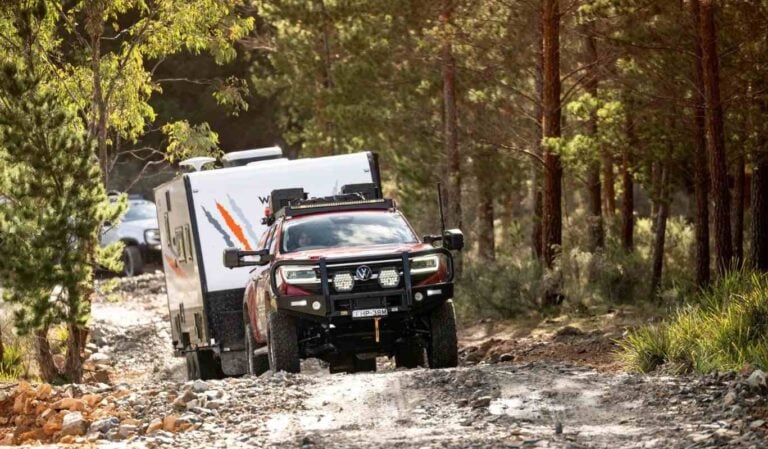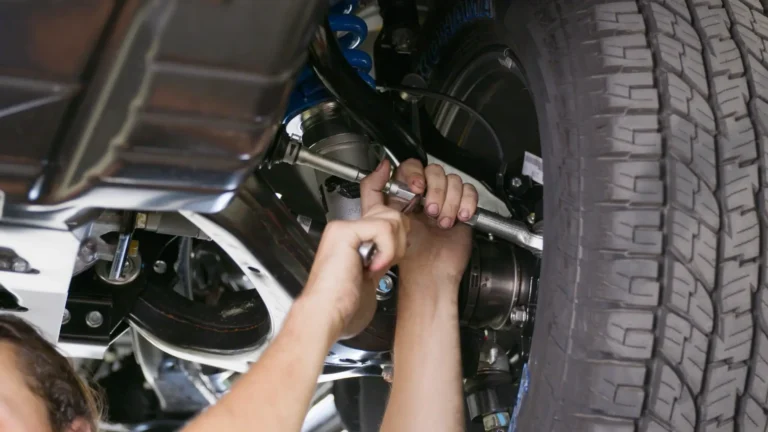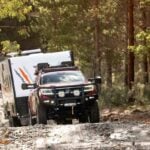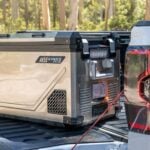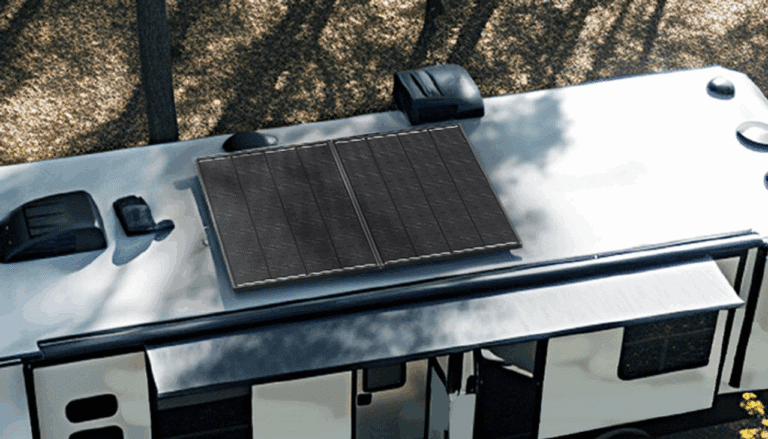
There’s really nothing like a good road trip. Whether it’s a weekend escape to your favourite campsite or a few months exploring Australia’s incredible landscapes, an RV adventure creates memories that last a lifetime. This comprehensive RV packing list ensures you’re prepared for anything the Australian outback throws your way.
But let’s be honest – packing an entire RV can feel overwhelming. A simple overnight bag won’t cut it, and with all the new technology and safety requirements, it’s easy to wonder if you’ve forgotten something crucial.
To help you prepare with confidence, here’s your complete guide covering everything from mandatory safety equipment to the latest power systems that’ll keep you comfortable wherever you roam.
Safety first: Essential RV packing checklist items
First and foremost, before we dive into the fun stuff, let’s cover the safety essentials. Several important regulations have come into effect recently, and getting these right isn’t just about compliance—it’s about protecting yourself and your loved ones on the road.
Mandatory safety equipment
Smoke alarms: If you’re travelling through Queensland, photoelectric smoke alarms became mandatory in July 2024 for all newly registered or transferred caravans. NSW has similar requirements for new registrations. You’ll need one with a 10-year sealed lithium battery, ceiling-mounted, and rated to handle road vibrations. Place at least one near sleeping areas and one in annexes if you use them overnight. Budget around $50-100 for a compliant unit.
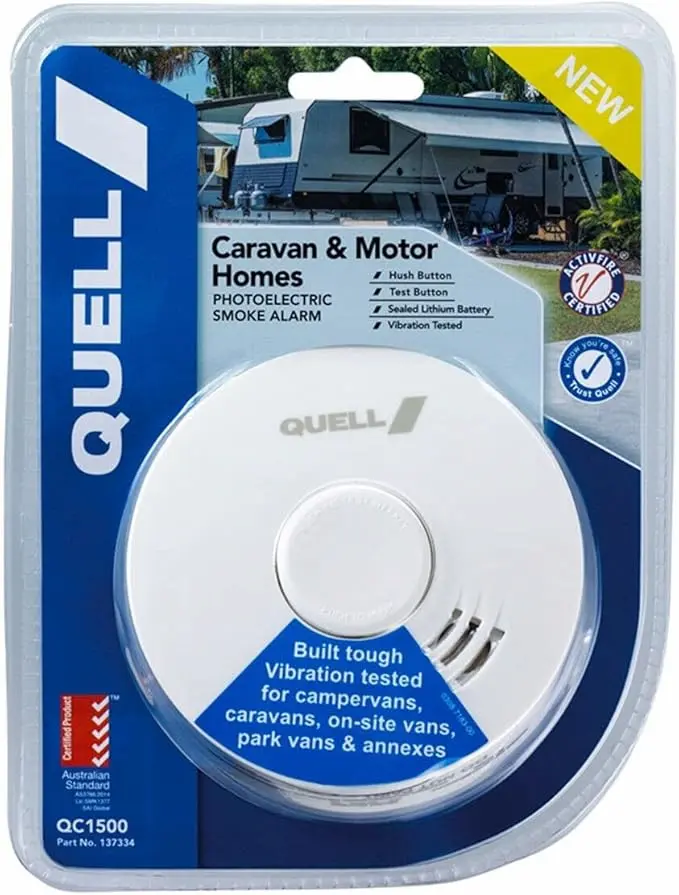
Carbon monoxide detectors: In addition to smoke alarms, these have become essential best practice if you’re using any gas appliances. Carbon monoxide is odourless and deadly, making detection critical. Look for combination smoke/CO units with 10-year sealed batteries ($50-100). Install at ceiling or head height, as CO has similar density to air.
Fire safety kit: Your RV must carry a fire extinguisher—it’s been mandatory for years under Australian Design Rule 44/01. However, with modern lithium battery systems, consider upgrading to an F-500 extinguisher capable of handling lithium-ion battery fires ($80-150). Standard ABE dry powder extinguishers work too ($30-80). Add a fire blanket for kitchen areas ($20-40) and ensure everything is securely mounted.
Gas system certification: Big changes here for 2025. Amendment 2 to AS/NZS 5601.2 became mandatory in March 2025, introducing new safety standards for gas installations. If you’re in Queensland, Section 113 now requires gas certification before any caravan resale. All gas systems need Type 21 POL connections with quick-connect devices, enhanced ventilation, and updated CO detector specifications where required.
Emergency communication
Personal Locator Beacons (PLBs): The ACR ResQLink 410 with Return Link Service ($500-600) represents the latest technology in emergency beacons. The game-changer? You get blue light confirmation that rescue coordination centres have received your distress signal, eliminating the uncertainty of older models. For weekend warriors, the ACR ResQLink 400 ($399) provides standard 406MHz GPS PLB functionality. Critical reminder: all PLBs must be registered with AMSA (it’s free and takes minutes online), and 406 MHz is now mandatory.
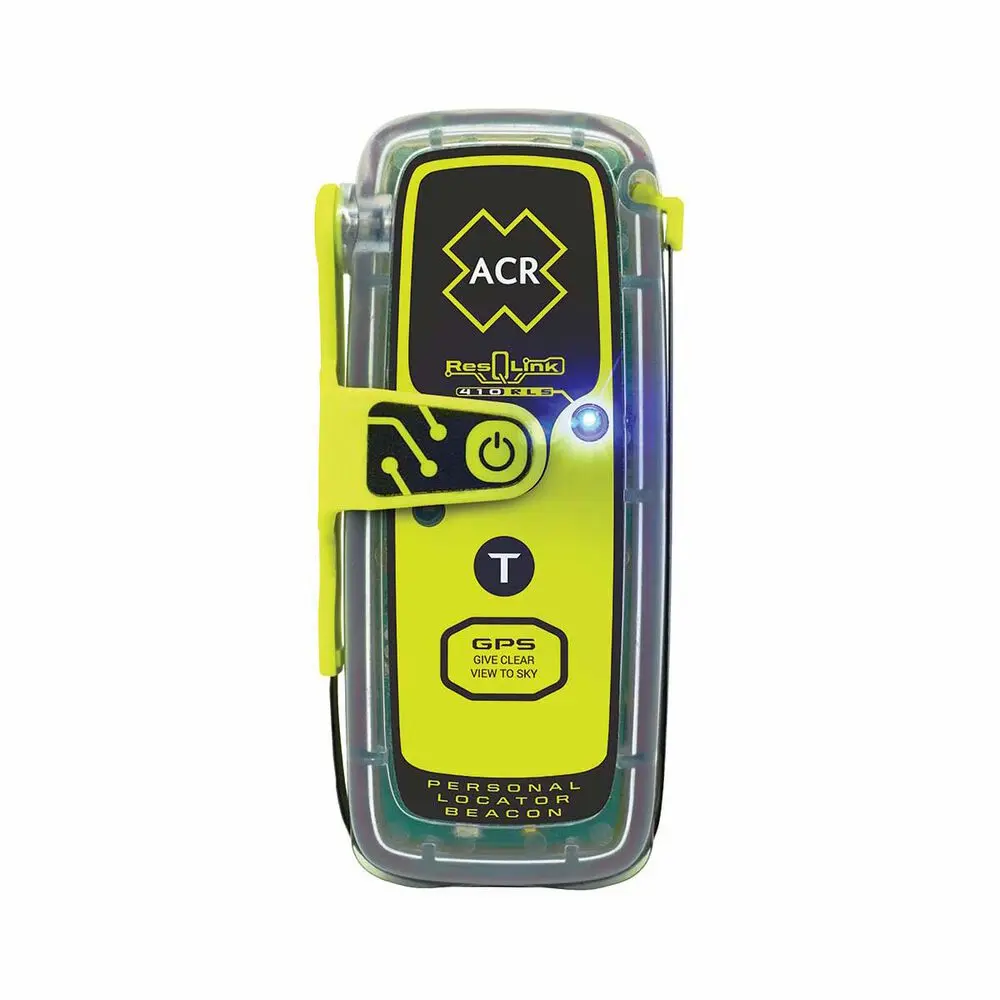
Satellite communicators: Similarly, for serious outback travel, devices like the Garmin inReach provide two-way messaging and SOS capability beyond PLB functionality. More on navigation options later.
First aid for Australian conditions
Australia’s unique hazards require specific first aid preparation. The SURVIVAL Snake Bite First Aid Kit ($90-130) includes pressure bandages with SMART tension indicators, snake bite instruction cards with CPR guidance, and weighs just 555g. This addresses the reality that 100 of Australia’s 170 snake species are venomous.
Your comprehensive first aid kit should include:
- Pressure immobilisation bandages (minimum 2 each of 5cm, 7.5cm, 10cm, 15cm)
- Trauma shears
- Antiseptic solutions and wound dressings
- Pain relief medication
- Antihistamines for allergic reactions
- Tweezers (for splinters and ticks)
- Digital thermometer
- Insect bite cream
- Sunburn treatment
- Personal medications with prescriptions
Vehicle documentation
Keep these accessible at all times:
- Driver’s licence and passengers’ IDs
- Vehicle and caravan registration
- Insurance (vehicle and caravan – yes, you need separate cover)
- Caravan compliance plate details
- Gas certification (if required in your state)
- Vehicle manuals for troubleshooting
Insurance note: Your tow vehicle insurance doesn’t cover caravan damage – you’ll need separate caravan insurance. KT Insurance and Club 4X4 Insurance specialise in caravan and RV coverage, offering comprehensive protection including contents, emergency accommodation, towing costs, and legal liability.
Off-grid power essentials for your caravan packing list
Meanwhile, RV travel has changed dramatically in this area. Modern power systems enable genuine off-grid capability that simply wasn’t possible a few years ago.
Portable solar generators
Portable solar generators have transformed from luxury items to must-have equipment for serious RV travellers. These units provide silent, emission-free power without the noise, fumes, and fuel costs of traditional petrol generators.
Weekend warrior: The Renogy Phoenix 200 offers portable power perfect for short trips. It handles lighting, device charging, and small 12V appliances without breaking the bank.
Regular traveller: Ecoflow River 2 Pro (768Wh, 1600W output) provides excellent capability for extended weekends and regular trips, running fridges, laptops, and most appliances with fast solar charging.
Big lapper: Ecoflow Delta Pro (3600Wh expandable to 25kWh, 3600W output) represents the pinnacle of portable power. This beast runs air conditioning, induction cooktops, and all appliances for extended periods. LiFePO4 batteries provide 3500+ charge cycles, meaning years of reliable service even with daily use.
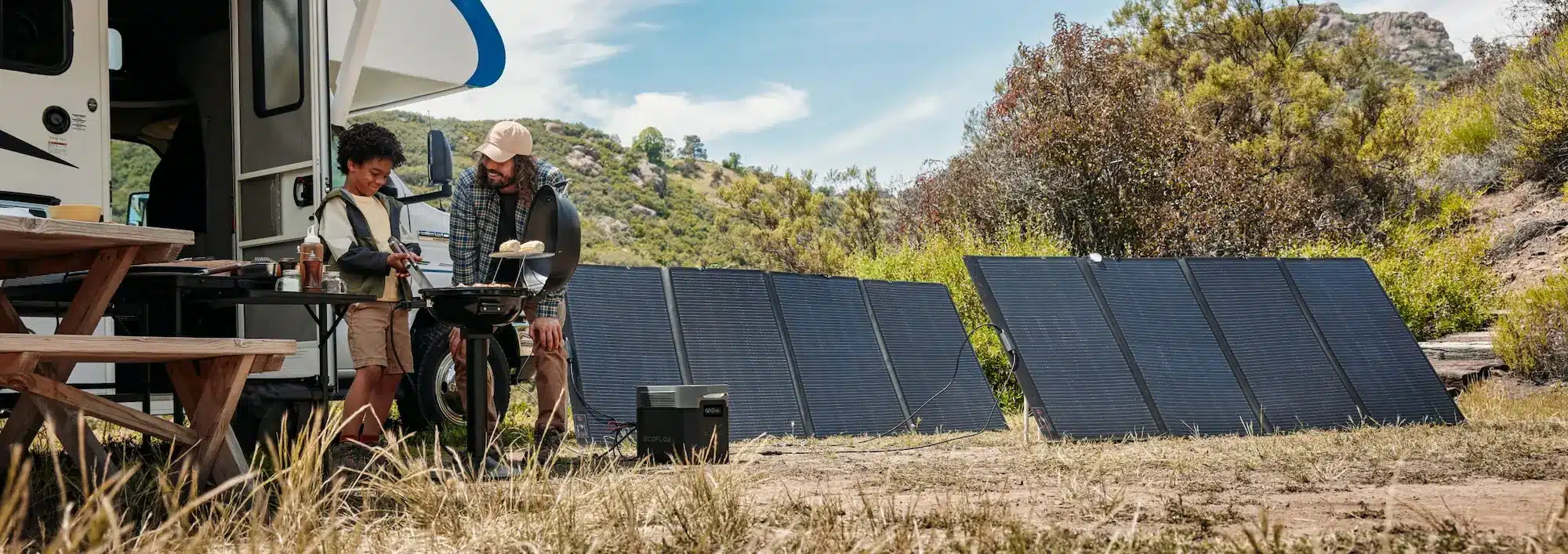
Lithium battery systems
If you’re still running traditional lead-acid batteries, lithium LiFePO4 technology offers game-changing advantages: 50% lighter weight, 3-5 times longer lifespan, stable voltage until nearly depleted, and usable capacity of 80-90% versus 50% for lead-acid.
Entry level: iTechworld iTECH100SX Slim (100Ah, $499)—weighs just 10.9kg and provides adequate capacity for weekend trips and basic off-grid camping. Perfect for getting started without a huge investment.
Mid-range: Renogy 12V 100Ah LiFePO4 battery offers quality construction with built-in BMS protection, suitable for regular travellers who need reliable power without premium pricing.
Advanced: iTechworld iTECH120X PRO (120Ah, $699-799)—features IP67 waterproof rating, Bluetooth BMS monitoring via smartphone app, suitable for under-bonnet installation, and backed by a 5-year warranty. At just 12.5kg, this battery delivers serious performance. For big lappers, dual iTechworld 120Ah batteries in parallel ($1,400) provide 240Ah total capacity, enabling extended free camping with heavy appliance use.
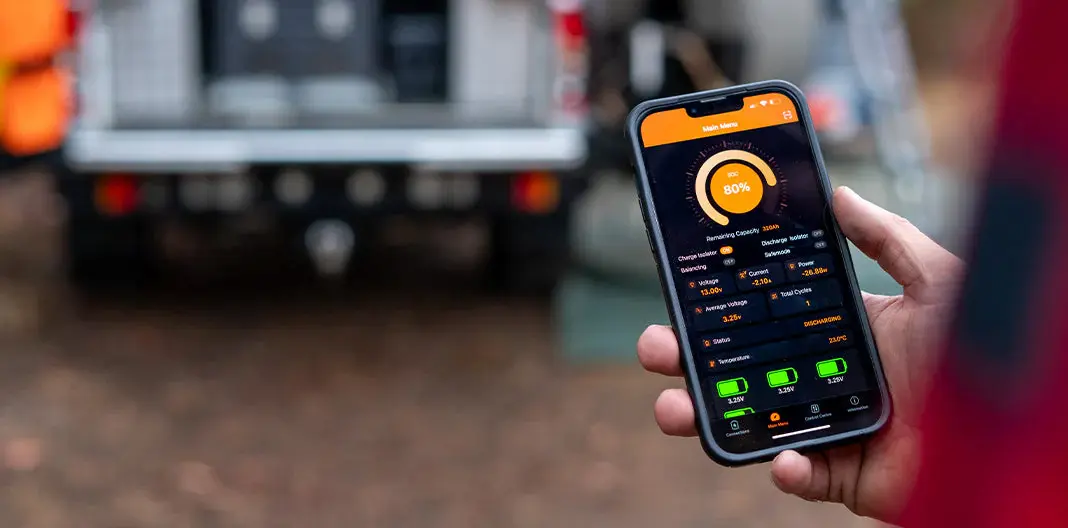
Solar charging systems
Solar panels have increased in both efficiency and affordability. For 2025, aim for 400-600W minimum for mid-tier setups. Portable solar panels offer flexibility, while fixed installations provide permanent charging capability.
Portable options: Renogy 200W foldable solar suitcase ($400-500) packs away easily and deploys in minutes. Perfect for positioning to capture optimal sun angles throughout the day. Weekend warriors can start with a 100W portable panel (~$200-300).
Fixed installations: Rigid monocrystalline panels with 22-23.5% efficiency, permanently mounted to your RV roof. A Renogy 400W array provides substantial charging even in overcast conditions. Australia’s high UV levels actually benefit solar generation. Read our complete guide to the best solar panels for caravanning and camping.
Solar charge controllers: The Redarc BCDC1225D dual-input charger ($699) is the gold standard across all experience levels. It combines solar and alternator charging with MPPT (Maximum Power Point Tracking) optimization. This 25A unit suits 75-200Ah battery banks and works with all battery chemistries including modern lithium systems. For larger setups with 200Ah+ banks, the BCDC1240D 40A version (~$800-900) handles higher charging currents.
Complete power system examples
Weekend warrior setup (~$1,200):
- iTechworld iTECH100SX 100Ah battery ($499)
- Renogy 100W portable solar panel ($250)
- Basic PWM controller ($100)
- 1000W pure sine wave inverter ($300)
Provides adequate power for lighting, device charging, 12V appliances, and occasional inverter use. Perfect for regular weekend escapes.
Regular traveller setup (~$2,200):
- Renogy 100Ah LiFePO4 battery ($700)
- Redarc BCDC1225D 25A charger ($699)
- Renogy 200W foldable solar ($450)
- 1500W pure sine wave inverter ($400)
Enables extended trips with reliable power for fridges, cooking, and entertainment systems.
Big lapper setup (~$3,700):
- Dual iTechworld iTECH120X PRO 120Ah batteries ($1,400)
- Redarc BCDC1240D 40A charger ($900)
- Renogy 400W fixed solar array ($800)
- 2000W pure sine wave inverter ($600)
Enables air conditioning, induction cooking, high-draw appliances, and extended off-grid capability measured in weeks rather than days. This is the setup for serious full-timers and lap-of-Australia adventures.
Navigation and connectivity: Motorhome packing checklist
GPS and mapping
Entry level: Smartphone apps like Hema Maps, WikiCamps, and CamperMate provide excellent navigation with offline map capability. Download maps before departing populated areas. Cost: $0-50 for premium app features.
Mid-range: Hema Navigator HN7 (~$400-500)—Australian specialist with 6000+ preloaded POIs covering caravan parks, fuel stops, and attractions unavailable in international GPS brands. Perfect for regular travellers who want reliability without premium pricing.
Advanced: Garmin Montana 700 ($899) features rugged 5″ touchscreen, preloaded TopoActive Australia/NZ maps, and MIL-STD-810 military-grade construction for corrugated roads and harsh conditions. For big lappers tackling remote tracks, the Garmin Montana 700i ($1,045) adds inReach satellite communication with two-way messaging and SOS capability, combining navigation and emergency comms in one unit.
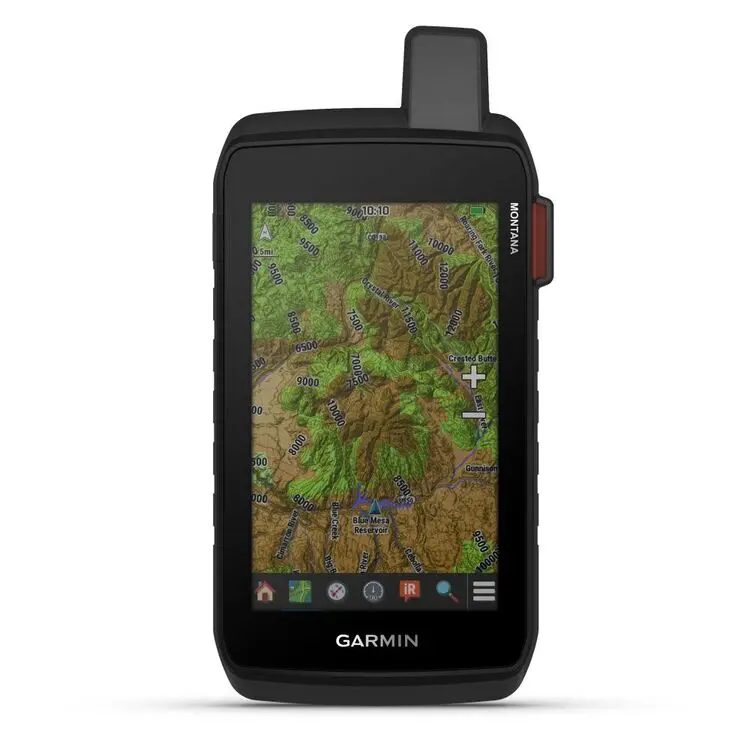
Internet connectivity
Starlink: Additionally, Starlink has revolutionised RV connectivity since its Australian rollout. The Starlink Mini kit recently dropped to $540 with monthly service from $80, while Starlink Roam ($174/month, pausable when not travelling) provides unlimited data suitable for streaming, remote work, and navigation updates. The critical advantage: Starlink now covers all of Australia including remote outback areas where mobile coverage is nonexistent. Hardware available from Officeworks, JB Hi-Fi, and directly from Starlink, with no long-term contracts. Considering Starlink for your RV or home? Read this guide for all your FAQs.
Mobile network boosters: The Cel-Fi GO R41 ROAM ($1,095) provides 5G compatibility, works across Telstra/Optus/Vodafone networks, and requires no ongoing subscription fees. This represents better value than Starlink for travellers who primarily need voice calls and basic data rather than high-speed streaming.
UHF radios: Essential for convoy travel and accessing UHF radio repeaters in remote areas. The Uniden X75 provides reliable communication on licence-free CB frequencies when all other systems fail. UHF remains the primary communication method for 4WD tracks and remote touring.
Kitchen and cooking: Essential caravan checklist items
Moving on to modern RV kitchens—they’ve evolved dramatically, with innovative 12V appliances enabling cooking without gas or heavy inverter loads.
Revolutionary 12V cooking
12V air fryers: The Road Chef 12V Portable Air Fryer ($289, available from Outback Equipment and The 12 Volt Shop) represents 2025’s most innovative kitchen development. Drawing 22A at 250W, it connects via Anderson plug and runs directly off your 12V system without inverters. The 3L capacity suits couples, while the On The Road 12V Air Fryer (300W, 6.5L, ~$300-350) offers larger capacity for families. This enables healthy cooking—chips, chicken, vegetables—entirely off-grid.
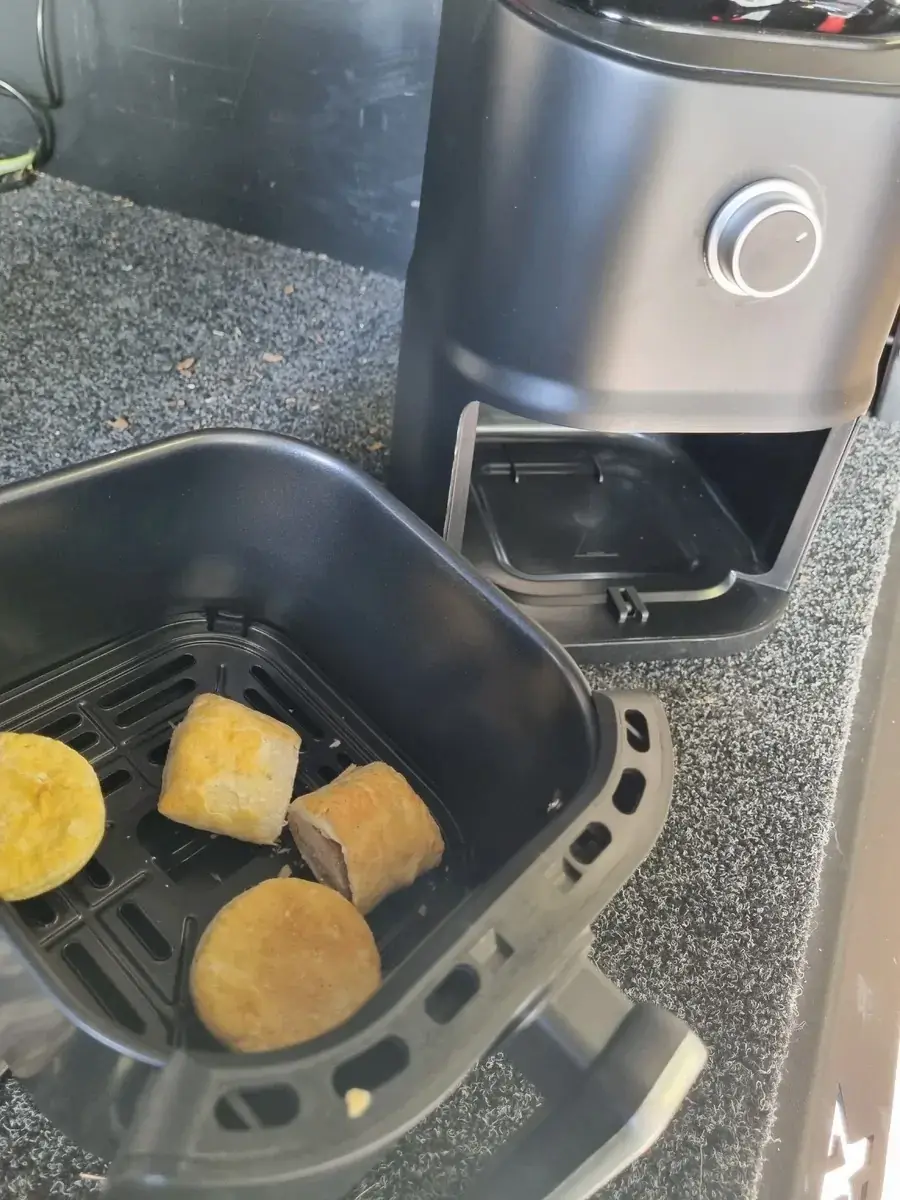
Induction cooktops: On the other hand, if you’ve invested in a quality lithium battery system, portable induction cooktops provide precise temperature control and rapid heating. Companion Roam and NCE make caravan-specific models ($100-300) that run efficiently on inverters, using less power than traditional electric hotplates.
Portable gas alternatives: For those preferring traditional cooking methods, portable dual-burner gas stoves remain popular. Ensure you carry adequate gas bottles and comply with storage regulations.
Refrigeration options
Weekend warrior: Quality esky with ice (~$100-300) works adequately for short trips with regular ice access. Simple, affordable, and gets the job done.
Regular traveller: Dometic CFX3 45L ($1,449)—the sweet spot for couples taking extended trips. True compressor refrigeration with 12V/24V/240V operation and minimal power draw. Mobile app control lets you monitor and adjust temperature remotely.
Big lapper: Dometic CFX3 75L ($1,999)—dual-zone capacity for families and full-timers, enabling separate fridge and freezer temperatures. This is the setup for lap-of-Australia trips where reliable refrigeration isn’t negotiable.
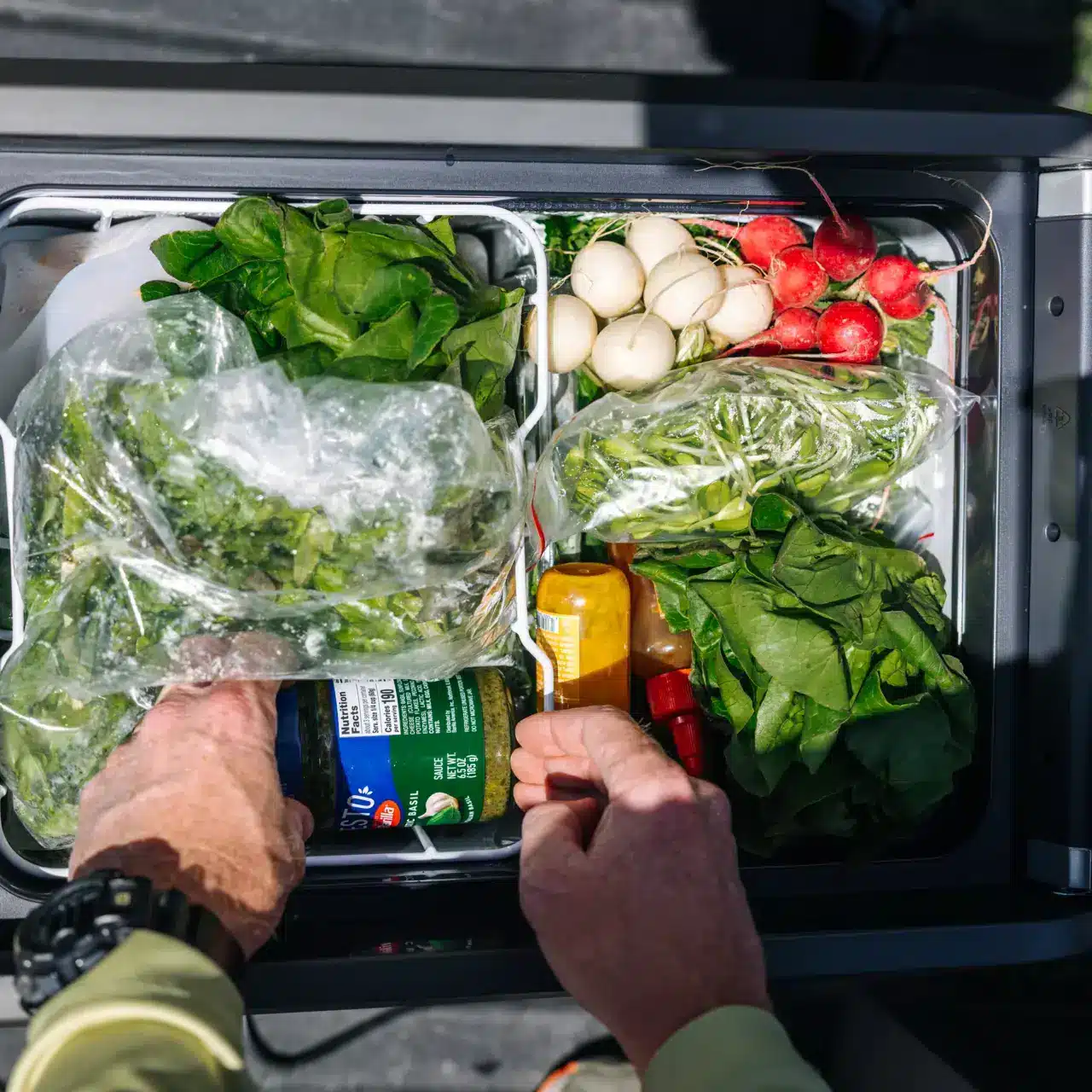
Essential kitchen items
Cooking equipment:
- Pots and pans (lightweight, nesting designs)
- Chopping boards (consider folding silicone versions)
- Sharp knives in protective sheaths
- Wooden spoons and spatulas
- Can opener and bottle opener
- Matches or lighter (backup even if using electric cooking)
General kitchen supplies:
- Reusable plates, bowls, and mugs
- Cutlery
- Food storage containers
- Rubbish bags (heavy-duty)
- Washing up liquid, sponge, and tea towels
- Dish drainer
- Esky or portable fridge
- Food and snacks (shelf-stable options for extended trips)
- Coffee maker (French press, stovetop espresso, or portable coffee machine)
- Reusable water bottles
- Water jerry cans (20L minimum for outback travel)
Water management
Water filtration systems: The Thirsty Nomad “5 in 1” water purifier handles town water, tank water, bore water, and creek water, meeting Australian Drinking Water Standards. This versatility is essential for outback travel where water quality varies dramatically. B.E.S.T. Water Filters’ Hi Flow Twin Caravan & RV Water Filter uses Silversafe technology for bacterial protection, processing up to 10 litres per minute.
Point-of-entry (POE) systems protect your entire caravan plumbing, while under-sink systems provide additional purification for drinking water.
Bedding and homewares
Subsequently, make your RV a true home away from home with comfortable bedding and thoughtful accessories.
Bedding essentials:
- Fitted sheets (RV mattresses often differ from standard sizes)
- Pillows and pillowcases
- Blankets or doonas (season-appropriate)
- Sleeping bags (backup, especially for unexpected cold nights)
- Mattress protector
Outdoor living:
- Foldable camping chairs (lumbar support models for comfort)
- Outdoor table (adjustable height, weatherproof)
- Hammock (perfect for lazy afternoons)
- Picnic rug or outdoor mat
Lighting:
- Head torch (hands-free convenience)
- Portable LED lanterns
- Fairy lights (atmosphere and gentle ambient lighting)
Modern LED lighting achieves 90% power reduction versus traditional bulbs with 10,000-25,000 hour lifespans. The Plusrite 26W Solar LED Camping Light extends to 1.9m height, delivers 3000 lumens, and includes power bank functionality.
Clothing for all conditions
Pack for the diverse climates you’ll encounter across Australia’s vast landscapes.
General clothing:
- Tops (mix of short and long sleeve)
- Trousers and shorts
- Underwear and socks (more than you think you’ll need)
- Warm layers (fleece, jumpers)
- Thermals (for cold nights and southern winters)
- Raincoat or weatherproof jacket
- Sleepwear
- Swimwear
- Wetsuits (if visiting coastal areas in cooler months)
Footwear:
- Comfortable walking shoes or trainers
- Flip-flops or sandals
- Waterproof boots (essential for wet season travel)
- Hiking boots (if planning walks)
Accessories:
- Wide-brimmed hat (Australia’s UV levels demand serious sun protection)
- Beanie (winter travel)
- Sunglasses (UV-rated)
- Prescription glasses (backup pair)
- Backpack or daypack
- Dry bags (waterproofing electronics and valuables)
- Beach towels and quick-dry camping towels
- Snorkelling gear (Australia’s coastline demands it)
Toiletries and personal care
Personal essentials:
- Toothbrush and toothpaste
- Biodegradable soap and shampoo (essential for environmental areas)
- Conditioner
- Razors and shaving cream
- Hair ties and hairbrush
- Makeup and remover (if desired)
- Feminine hygiene products
- Deodorant
- Personal medications with prescriptions
Sun protection (absolutely critical):
- SPF 50+ sunscreen (multiple bottles—Australia has the world’s harshest UV)
- Reef-safe sunscreen (mandatory for tropical reef areas)
- Insect repellent (tropical-strength for northern Australia)
- After-sun lotion
- Lip balm with SPF
Additional hygiene:
- Hand sanitiser
- Wet wipes
- Toilet paper (always carry extra)
- Laundry detergent (for longer trips)
- Portable washing solutions (twin-tub or compact machines)
Seasonal RV packing variations
Australia’s diverse climate zones require strategic seasonal packing.
Summer essentials (December-February)
- Multiple types of SPF 50+ sunscreen
- Cooling towels and scarves
- 12V portable fans (rechargeable models)
- Extra water storage capacity
- UV reflective window shades
- Light-coloured, breathable clothing
- Sand-free beach towels
- Insulated drink holders
Important: Book caravan parks months in advance for school holidays (mid-December to early February). Outback travel can be brutally hot—many experienced travellers avoid the Top End during wet season.
Winter packing (June-August)
- Quality sleeping bags (temperature-rated)
- Thermal blankets and underlays
- Multiple layering options
- Weatherproof outer shells
- Warm socks and gloves
- Portable 12V heater
- Hot water bottles
- Snow chains (mandatory in alpine areas)
- Antifreeze for water systems (if travelling cold regions)
Regional note: Winter is perfect for tropical North Australia. The dry season (May-October) provides ideal conditions in Darwin, Cairns, and North Queensland with minimal rain and comfortable temperatures.
Outback and remote travel additions
- Extra fuel (plan for 200km+ between services)
- Significantly increased water storage
- Sand tracks and recovery boards (2 pairs)
- D-shackles (rated appropriately for vehicle weight)
- UHF radio (essential, not optional)
- PLB or satellite communicator (mandatory for safety)
- Comprehensive first aid including snake bite treatment
- Extensive spare parts kit
- Red dust-proof storage solutions
- Extra sun protection gear
Entertainment and adventure gear
Screen-free entertainment:
- Books and e-readers
- Board games and playing cards
- Travel journal
- Colouring books and art supplies
- Binoculars for wildlife watching
Adventure equipment (activity-specific):
- Kayak or stand-up paddleboard
- Fishing rods and tackle
- Bicycles with secure mounting
- Surfboard
- Hiking gear and walking poles
- Camera equipment
Emergency roadside kit
Essential tools and spares:
- Jumper leads
- Tyre pressure gauge and pump
- Flashlight with extra batteries
- High-visibility vest
- Basic toolkit (spanners, screwdrivers, pliers)
- Duct tape and cable ties
- Spare bulbs and fuses
- Fan belts and hoses (longer trips)
- Emergency cash
Recovery equipment:
- Spare tyres (caravan and vehicle)
- Wheel brace and jack
- Recovery straps (rated appropriately)
- Work gloves
Your complete RV packing list: Ready for adventure
Finally, the key to successful RV packing lies in balancing preparation with flexibility. Modern power systems enable genuine self-sufficiency, safety equipment provides peace of mind, and thoughtful packing ensures comfort wherever you roam.
Start with the essentials – safety equipment, power systems, and navigation tools form your foundation. Build from there based on your travel style, destination, and season. Remember that less is often more; you can usually purchase forgotten items along the way, and overloading your RV affects fuel economy and handling.
Whether you’re a weekend warrior taking your first short trip, a regular traveller exploring your home state, or a big lapper preparing for the journey of a lifetime around Australia, this RV packing list has you covered. Most importantly, embrace the freedom that RV travel provides. With the right preparation, you’re ready for spontaneous detours, extended off-grid camps, and unforgettable Australian adventures.
Read Next
10 Essential items for free camping off-grid in your RV



